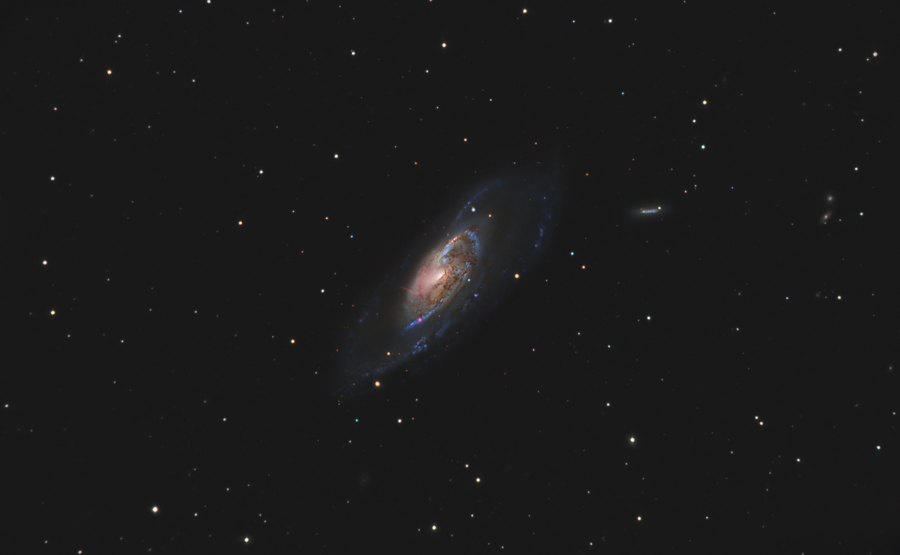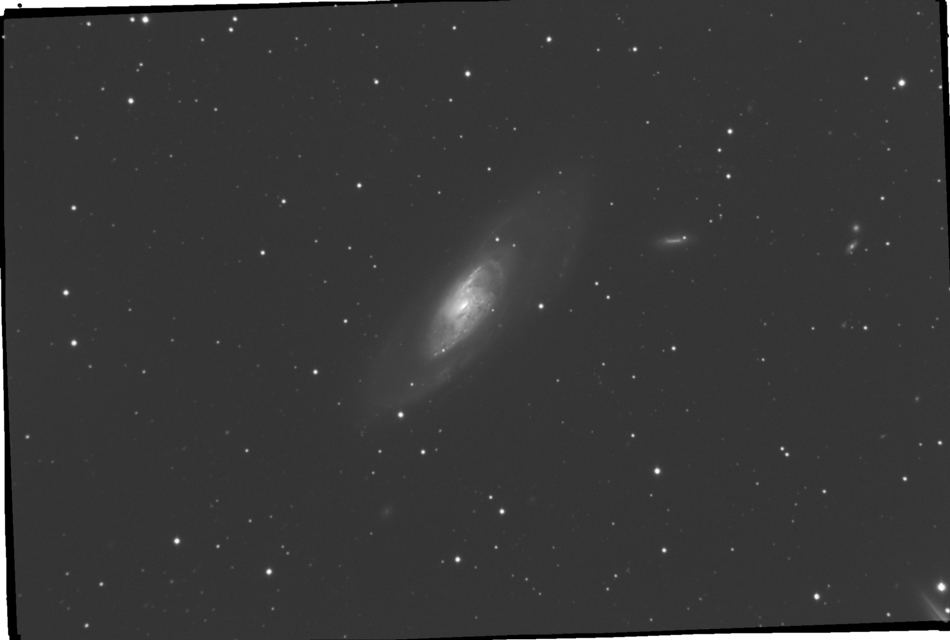© 2021 Michael A. Siniscalchi
Messier 106
Spiral Galaxy in Canes Venatici
RA:12h 17m 28s Dec: +47° 13' 14" Distance - 23 mly Size - 135,000 ly
Click on image for larger size
Wikipedia
Messier 106 (also known as NGC 4258) is an intermediate spiral galaxy in the constellation Canes Venatici. It was discovered by Pierre Méchain in 1781. M106 is at a distance of about 22 to 25 million light-years away from Earth. M106 contains an active nucleus classified as a Type 2 Seyfert, and the presence of a central supermassive black hole has been demonstrated from radio-wavelength observations of the rotation of a disk of molecular gas orbiting within the inner light-year around the black hole. NGC 4217 (seen to the right) is a possible companion galaxy of Messier 106
M106 has a water vapor megamaser (the equivalent of a laser operating in microwave instead of visible light and on a galactic scale) that is seen by the 22-GHz line of ortho-H2O that evidences dense and warm molecular gas. These water vapors give M106 its characteristic purple color. Water masers are useful to observe nuclear accretion disks in active galaxies. The water masers in M106 enabled the first case of a direct measurement of the distance to a galaxy, thereby providing an independent anchor for the cosmic distance ladder. M106 has a slightly warped, thin, almost edge-on Keplerian disc which is on a subparsec scale. It surrounds a central area with mass 4 × 107M. It is one of the largest and brightest nearby galaxies, similar in size and luminosity to the Andromeda Galaxy
About the red verticle jets-
The long exposures in Hydrogen Alpha for the image shown below display the glowing hydrogen gas filaments that appear to be coming from the galaxy center.
Further explanation from NASA.gov: Most spiral galaxies only have one pair of arms, but M106 has an extra set, seen here as red wisps of gas. Unlike the other arms, these two extra arms are made up of hot gas rather than stars. Astronomers attribute these ghostly arms to the supermassive black hole at the galaxy’s center. The extra arms appear to be an indirect result of the violent churning of matter around the black hole.
Initial stretch of 8 hours total exposure using a 5nm Hydrogen alpha filter is shown above. The TMB 130 refractor used for this image is 910mm though this galaxy is better displayed using a longer focal length to resolve the finer details.
This is the first image I used Topaz Gigapixel AI to increase the size by 200% to further highlight details, then reduce the size back to 100% using Photoshop's Preserve Details 2.0 then mask and brush through areas I wanted to apply more details.
I've used the upsizing technique on several images before using just Photoshop but this is the first with Topaz Gigapixel AI. I was very surprised how well Topaz enlarges images while maintaining accurate details and the results look as if the object was imaged with a longer focal length OTA.
This is a 210 minute luminance frame after initial stretch. Notice the verticle jet isn't visible.
Click on image for a larger view
M106 enhanced by GigaPixel AI. This is enlarged 2X before processing. It is then reduced by 50% to restore the native image scale using Photoshops Preserve Details 2.0 resampling.
This consumes a lot of processor power so don't use a clunker.


